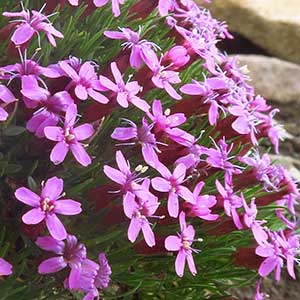Silene stellata
Silene acaulis
starry campion, widow's frill
moss campion, silène acaule
several, simple proximal to inflorescence, 30–80 cm, puberulent, becoming subglabrous near base.
erect, leafy proximally, 3–6(–15) cm, old leaves persistent at base.
withering proximally, in whorls of 4, ± sessile to short-petiolate, largest in mid-stem region;
blade lanceolate to ovate-lanceolate, 3–10 cm × 4–40 mm, apex acuminate, puberulent on both surfaces, sparsely so adaxially.
mostly basal, densely crowded and imbricate, sessile;
blade 1(–3)-veined, linear-subulate to lanceolate, 0.4–1(–1.5) cm × 0.8–1.5(–2) mm, margins cartilaginous, often ciliolate especially proximally, apex acute, glabrous to scabrous.
paniculate, open, bracteate, bracteolate, branches elongate, puberulent;
bracts and bracteoles linear-lanceolate, 2–15 mm.
solitary flowers.
straight, often with 1 or 2 pairs of bracteoles, slender, 1/2–3 times calyx, glabrous or scabrous-puberulous.
2–40 mm.
calyx obscurely 10-veined, broadly campanulate, becoming obtriangular in fruit, 7–11 × 6–10 mm, herbaceous, margins dentate, very narrow, membranous, sparsely puberulent, lobes broadly triangular, 2–3 mm;
corolla white, ca. 2 times longer than calyx, limb obtriangular, narrowed into claw, divided ca. 1/2 its length into 4–12 lobes, appendages absent;
stamens equaling petals;
styles 3, longer than petals.
bisexual or unisexual, all plants having both staminate and pistillate flowers, others having only pistillate flowers, subsessile or borne singly on peduncle;
calyx 10-veined, lateral veins absent, tubular to campanulate, (5–)7–10 mm, herbaceous, margins often purple tinged, dentate, sometimes ciliate, ± scarious, glabrous, lobes lanceolate to ovate, 1–2 mm;
petals bright pink, rarely white, limb unlobed to shallowly 2-fid, 2.5–3.5 mm, base tapered into claw, auricles and appendages poorly developed;
stamens exserted in staminate flowers, not so or aborted in pistillate flowers;
styles 3.
globose, opening by 3 broadly triangular teeth;
carpophore 2–3 mm.
3-locular, cylindric, equaling or to 2 times calyx, opening by 6 recurved teeth;
carpophore ca. 1 mm.
dark brown, reniform, ca. 1 mm, papillate.
light brown, reniform, 0.8–1(–1.2) mm broad, dull, shallowly rugose.
= (34), 48.
= 24.
Silene stellata
Silene acaulis
Silene stellata is a very distinct species with its broadly lanceolate leaves in groups of four at each node, and its brilliant white, multilobed petals. Two varieties are recognized by some workers: var. stellata, with glabrous pedicels; and var. scabrella, with scabrous pedicels. The former tends to have longer, more slender pedicels and be more common towards the northeast, whereas the latter tends to be more western. The correlation of characters and distribution is poor, however, and intermediate plants are often encountered.
Silene stellata was collected near the Grand River, Cambridge, Ontario, in 1941, but was probably introduced there and has not been seen since.
(Discussion copyrighted by Flora of North America; reprinted with permission.)
Silene acaulis is a variable species, and most workers have recognized infraspecific taxa in North America: subsp. acaulis (subsp. exscapa and subsp. arctica), which is predominantly arctic; and subsp. subacaulescens, which extends down the Rocky Mountains from Alaska to Arizona and New Mexico. In subsp. acaulis, the leaves are flat and short and the flowers are subsessile and smaller in size. Subspecies subacaulescens is typically a larger, less-compact plant with longer, narrower leaves and larger, pedunculate flowers. However, in many populations, these two variants are poorly differentiated, and in others both occur together, connected by intermediates.
Silene acaulis is widely distributed in arctic and alpine Europe.
(Discussion copyrighted by Flora of North America; reprinted with permission.)


